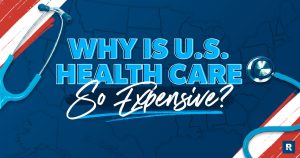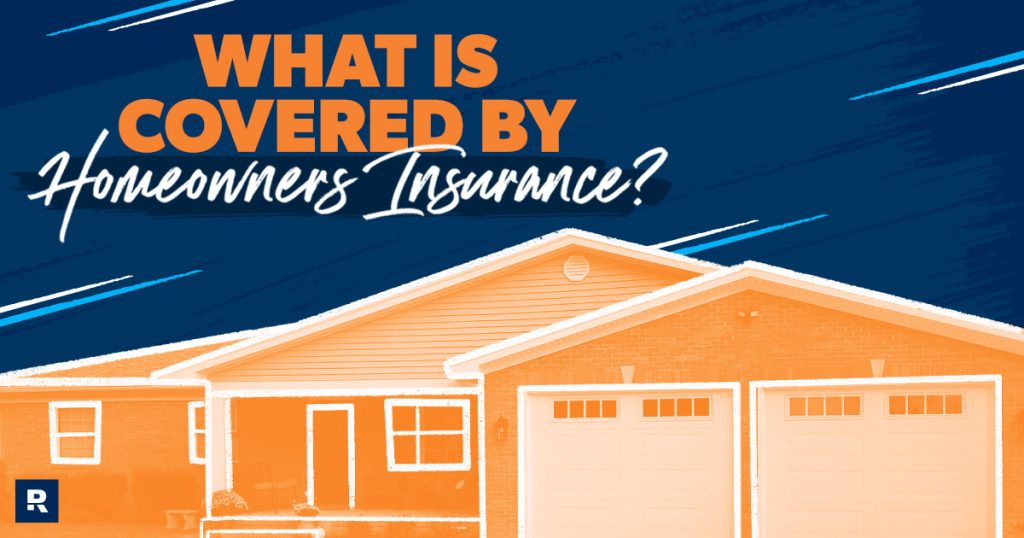Ahhhh. Home sweet home. There’s nothing like that feeling after coming home after a long trip away. Or that moment you get the keys to your first house and you walk through the front door, lay down, and do snow angels on that plush living room carpet (weird, but we get it).
But now that the new-home smell has worn off, it might be time to double-check your homeowners insurance coverage. Or maybe you’re getting homeowners insurance for the first time and you’re wondering, How much do I really need? And what does homeowners insurance cover?
Homeowners insurance can be confusing. If your basement floods, are you covered? Or what if a tornado sweeps through your neighborhood and pulls your roof off? Are you on the hook for the repairs?
Never fear! We’ll explain what a standard homeowners insurance policy actually covers in plain English so you know if your biggest asset is protected.
Let’s dig in!
What Is Homeowners Insurance?
Homeowners insurance is financial protection for your home and personal belongings in case they’re damaged or destroyed. It’s a way to transfer risk to an insurance company to avoid budget-busting events.
Having the right amount of homeowners insurance can make a huge difference in you reaching your financial goals. For most people, their home is their biggest investment. So the last thing you want is to be underinsured. But you also don’t want to pay extra for the coverage you need.
Homeowners Insurance Definition
Homeowners insurance is a type of property insurance that helps pay for your home to be rebuilt or repaired and your possessions replaced if these are damaged in a covered event like an accident, natural disaster or fire. It will also pay for medical bills and lawsuit costs if someone is injured on your property (think Fido biting the mailman or other injuries).
Types of Homeowners Insurance Policies
Insurance policies for people who live inside (as opposed to people who live in, you know, trees) are divided into eight different types of policies named HO-1, HO-2, etc., all the way to HO-8. Ranging from low coverage to high coverage, they’re also sorted by dwelling type (aka house, condo, etc.) and whether you own it or rent it.
Most insurance companies only sell HO-3 policies to single-family homeowners, but here’s the full list:
HO-1 and HO-2: These offer only bare-bones coverage—much less than what you would generally want if you owned a home.
HO-3: This is the most common type of policy homeowners select. It provides the standard level of coverage for your dwelling and personal property. Your personal property is protected up to a limit (usually 50% of your dwelling coverage).
These policies typically come with actual cash value (ACV) coverage for all your stuff in your home. This means you get paid what your stuff is worth at the time it was damaged or destroyed (aka the used value which includes depreciation). Not ideal.
HO-4: This is renters insurance. It covers everything the renter owns and offers personal liability coverage in case anyone is injured on the property.
HO-5: Along with HO-3, this is the other policy that a single-family homeowner would buy. These policies offer the highest levels of coverage and are more expensive. But they’re worth it because if your home and belongings are ever destroyed, you’ll be starting over, and you’re going to need all the help you can get.
With this kind of policy, you’ll get replacement cost value (RCV) coverage which means your insurance will pay whatever it costs to replace your stuff. You may also be able to find a policy that has guaranteed replacement cost value—which is like RCV for your house structure.
Protect your home and your budget with the right coverage!
HO-6: This is condo insurance. It covers your unit’s walls, floors and ceilings plus everything else a typical HO-3 policy covers, like liability and personal property.
HO-7: Folks who live in a mobile home or manufactured home need this kind of policy. Coverage usually only applies when your home is not moving.
HO-8: This policy is designed to cover the proud owners of a historic home. They’re expensive because old homes fall apart a lot, and repairs require special expertise and materials. It also provides the other typical coverages, like liability and personal property.
What Does Homeowners Insurance Cover?
Like most types of insurance, homeowners insurance is not just one overarching policy that protects you against anything that could happen. In reality, there’s an almost endless number of ways to customize your homeowners policy.
That’s why knowing the basics of coverage is so crucial. It’s the first step toward getting the right amount of coverage. (And if you’re wondering what your current coverage looks like, check out your insurance declaration page to see a breakdown of your policy.)
So, what does home insurance cover?
6 Types of Home Insurance Coverage
A standard homeowners insurance policy addresses five things:
- Dwelling
- Other Structures
- Personal Property
- Loss of Use (Additional Living Expenses)
- Personal Liability
- Medical Payments
Here’s a look at how each part works to provide you a solid foundation of protection. (To get the full picture of what kind of home insurance coverage is available, check out our Homeowners Insurance Guide.)
Dwelling Coverage
Dwelling coverage pays to repair or rebuild your dwelling (aka your house and anything attached to it) due to damage from disasters (also known as hazards), like:
- Fire
- Windstorms
- Hail
- Lightning
- Theft
- Vandalism
Let’s see how dwelling coverage could help you in three different scenarios.
- Example 1: A tornado destroys your roof. With dwelling coverage, your insurance company will pay to replace the roof.
- Example 2: Your garage catches fire. Your insurance carrier will pay to rebuild it if you have dwelling coverage. But if your garage was detached, you’d need additional coverage called other structures coverage (more on that in a second).
- Example 3: If you live in a coastal area that gets hit by hurricanes, dwelling coverage won’t cover wind or flooding damage. You’ll need separate policies for that—and if you live near water, you’ll probably need additional coverage for flooding too.
Other Structures Coverage
Other structures coverage is just what it sounds like: It covers buildings other than your house. But what counts as a structure? Here are some examples:
- Detached garage
- Tool shed
- Barn
- Gazebo
- Swimming pool
- Fence
- Driveway
Basically, a structure is a permanent feature that’s been built on your property. But there are limits to how much the insurance company will pay to repair or replace these structures—usually around 10% of the total policy you have on your house.
Let’s go back to that tornado for a second (sorry, but these are just scenarios). It not only destroyed your roof but also turned your tool shed into kindling (ouch!). Let’s say you have a $200,000 policy on your home. The insurance company will pay up to $20,000 (10%) to repair or replace the shed.
Different policies cover different structures, so make sure the structures on your property are actually covered in your policy. This is one big reason we recommend working with a trusted independent insurance agent to look at your unique situation.
Personal Property Coverage
Personal property coverage protects what’s in your home.
Imagine coming home one day to find that thieves broke into your home and stole your vintage baseball card collection. While you can’t get back the time and emotion that went into collecting all those cards, at least your insurance will pay you for its monetary value.
Personal property coverage protects your stuff, like clothes, furniture and electronics. It also covers expensive items like jewelry, art and collectibles. That said, there’s often a dollar limit attached to those high-end items—so you need enough homeowners insurance to replace damaged or stolen valuables.
Most insurance companies will cover your belongings up to around 50% to 70% of the value of your home. So in a situation where your whole home is destroyed and your house is valued at $300,000, you could expect coverage up to around $210,000 for your belongings. (Like we mentioned earlier, we recommend an RCV instead of an ACV policy so you get enough cash to replace the items lost—not just what the used item’s value was when it was lost or destroyed.)
A lot of us underestimate what our stuff is worth. You don’t want to end up with a reimbursement check that doesn’t actually cover your losses. So, to make sure your stuff is actually covered, pour yourself a strong cup of coffee, get out your clipboard or phone, and take a few hours on a Sunday to inventory all your stuff.
Loss of Use (Additional Living Expenses)
Some disasters do so much damage that you can’t actually live in your home until it’s fixed. Whether it’s for a few days or a few months, loss of use or additional living expenses (ALE) coverage will help you pay for the expenses of living away from home due to damage from an insured disaster.
That includes things like hotel bills, restaurant meals, pet care, transportation and even moving expenses if you’re out of your home for a while. But keep in mind that loss of use won’t pay for all your expenses. It only kicks in for costs that are over and above regular living expenses.
If a fire forces you into temporary homelessness, you might have to stay in a hotel for a month or so. And if the hotel room doesn’t have a kitchen, you’ll be eating out a lot. On top of that, you’ll still have to pay your mortgage. Let’s look at some sample expenses:
Normal Costs:
$1,200 mortgage + $600 groceries = $1,800
Costs After the Fire:
$3,000 hotel + $1,200 mortgage + $1,800 restaurants = $6,000
That’s a huge increase—you can see why you’ll need ALE!
Since loss of use only pays for extra expenses, it won’t cover the $1,200 mortgage. And since you didn’t have to buy groceries, the insurance company will subtract your normal grocery budget from the amount you spent eating at restaurants.
So, let’s see what ALE actually pays for:
Costs ALE Covers:
$6,000 – $1,200 mortgage – $600 groceries = $4,200
Loss of use has limits—usually around 20% of your dwelling coverage. And it’s designed to help you maintain your standard of living, not live luxuriously on the insurance company’s dime. (If you try that, your claim’s going to get denied. Yikes!)
But when you use ALE right, it’s one of the most helpful coverages to have after a disaster.
Personal Liability Coverage
Personal liability protection is one of the best types of homeowners insurance you can buy. It protects you from lawsuits for bodily injury and property damage that occurs on your property (and even sometimes off—like say your dog bites someone in the park). Let’s look at what happens when a married couple doesn’t have this coverage versus when they do.
Tom and Amy invited their new neighbors over for dinner. Their neighbor’s son jumped off the staircase and broke his arm. Now the neighbor is suing for $500,000. (Sadly, this happens more often than you might think.)
Without liability insurance, Tom and Amy would be in big trouble. They would have to pay thousands of dollars for lawyers. And if they lost the lawsuit, they could lose everything they own.
But good news! Tom and Amy have liability coverage. The insurance company will pay for legal representation and cover the damages if Tom and Amy are found responsible for the accident.
More good news: Personal liability coverage doesn’t cost much, so you can get plenty of it at a reasonable rate. You should carry at least $500,000 in liability because—let’s be real—no one sues for $250,000. And if you have a larger net worth, you should also look into umbrella insurance to protect everything you’ve worked for.
Medical Payments
Have you ever worried what would happen if someone tripped over that part of your sidewalk the massive oak tree roots pushed up? What if they broke their kneecap and needed surgery? That’s expensive—who pays for that? Home insurance, actually. Medical payments coverage can foot the bill for people injured on your property.
This coverage is often mentioned along with personal liability because the incidents covered often overlap (aka that person who trips on the sidewalk and needs surgery could easily sue you). But it doesn’t have to be your fault for medical payments coverage to kick in.
It doesn’t have to be that massive of an injury either. It could be that your cat got real feisty and gouged your friend deeply enough they need stitches. Medical payments coverage will cover that as well if you choose to make a claim. Just keep in mind, if you make a lot of claims your premiums could go up.

What Homeowners Insurance Won’t Cover
At this point you may be thinking, Wow, is there anything home insurance doesn’t cover? And unfortunately, the answer is yes. While home insurance covers you if you’re hit by many disasters, it won’t cover everything.
Incidents Standard Coverage Will Not Pay For
- Power failure
- Water damage from floods and sewer backups
- Hurricanes (flooding and sometimes wind damage)
- Neglect
- Earth movement, like sinkholes (most states) and earthquakes
- Ordinance of law, such as eminent domain or repairs/rebuilding to local code/ordinances
- Shrinking, settling or expansion of structure, including foundation or patios/pavement, etc.
- Intentional destruction (No, you can’t set fire to your house to get a new one. That’s called arson, and it’s frowned on in most places.)
- Vermin (rodents, birds or insects)
- Pet damage (If your Bengal uses the sofa as a scratching post, you’ll have to replace that on your own dime.)
- Smog, dry rot, rust and sometimes mold
- Wear and tear
- War or nuclear hazard
Your policy will list a full rundown of all the exclusions so make sure you check that out to see what you’re still on the hook for.
Personal Property That’s Not Covered
There are some exclusions for stuff home insurance won’t pay to repair or replace as well. We’re talking personal property exclusions. There are some things you might think fit in that category that it doesn’t cover.
Home insurance won’t cover your car if it’s damaged or stolen or your expensive boat or jet ski. It also won’t cover your high-value items, like jewelry, fine art and collectibles—so don’t worry, your Beanie Baby collection is fully protected.
Expand Your Coverage With Endorsements
If all these exclusions have you worried you’re not covered enough, don’t stress—that’s where endorsements come in. No, we’re not talking about making extra cash by telling your zillions of followers you love and use Native deodorant every day. We’re talking about add-ons to your policy—also called riders.
With a rider, you can get extra coverage for a specific thing. This could be a mold rider that covers mold damage, a building code rider that covers rebuilding up to newer codes (good for an old house), or a water backup rider that covers you in case a backed-up sump pump floods your house.
Another kind of rider involves personal property and it’s called scheduling, which means you insure specific items individually for specific amounts. This is how you get your really valuable stuff covered.
The list of endorsements you can get goes on and on, so if you’re worried about something in particular, see if you can add an endorsement to your policy to give yourself that extra peace of mind. If you’re not sure whether you need extra coverage, talk to a RamseyTrusted insurance pro. They’re experts and can help you figure out what you need.
That’s what Kim H. from the Ramsey Baby Steps Facebook Community group did.
“I used a RamseyTrusted insurance pro and ended up saving a lot—and got insurance better suited for my home and car,” she said. “I was overinsured in some areas and underinsured in others.”

Will Homeowners Insurance Cover . . . ?
To get a better idea of what kind of policy and possible extras you may need, let’s get even more detailed and look at the kinds of damage and causes insurance will and won’t usually cover.
|
What Is and Isn’t Usually Covered by Basic Homeowners Insurance |
|||
|
Incident |
Covered |
Sometimes Covered |
Not Covered |
|
Damage to trees, plants, shrubs |
X | ||
|
Lightning |
X | ||
|
Fires |
X | ||
|
Hail |
X | ||
|
Windstorms |
X | ||
|
Theft/vandalism |
X | ||
|
Damage from falling tree |
X | ||
|
Roof leaks |
X | ||
|
Roof replacement |
X | ||
|
Plumbing issues |
X | ||
|
Dog bites |
X | ||
|
Water damage |
X | ||
|
Mold |
X | ||
|
Air conditioning units |
X | ||
|
Foundation damage |
X | ||
|
Fence repairs |
X | ||
|
Earthquakes |
X | ||
|
Hurricanes |
X | ||
|
Termites |
X | ||
|
Flooding |
X | ||
What Does Homeowners Insurance Cost?
Now that we’ve answered, What does homeowners insurance cover?—we’re ready to look at how much it costs. In 2021, the price of an average homeowners insurance policy premium was $1,398 per year.1
However, the cost of homeowners insurance ranges widely depending on a ton of factors—things like the value of your home, your past history of homeowners insurance claims, your credit score, the level of your coverage, how much your stuff is worth, where you live, and whether you need extras like flood or hurricane insurance.
How to Get the Right Homeowners Insurance
The typical homeowners insurance policy gives you a lot of bang for your buck. We saw that you’ll be covered from a ton of different bad things that could happen. And there are also extras you can add to your policy if you need more coverage. But then there are those incidents it doesn’t cover (like flooding) that can be tricky to figure out.
That said, you might be wondering, How do I know I have the right level of home insurance coverage?
Great question! When it comes to something as important as protecting your home, we recommend working with a top-notch insurance agent. With so many things to consider, it’s crucial to work with someone you can trust to make sure you have enough coverage.
That’s where our RamseyTrusted local insurance pros can help. They’re experts who can look at your unique situation to help you find the sweet spot of coverage. And they’re independent insurance agents, which means they don’t work for anyone but you—so you can know you’re getting the best deal. You’ll be protected and save money.
Read the full article here










